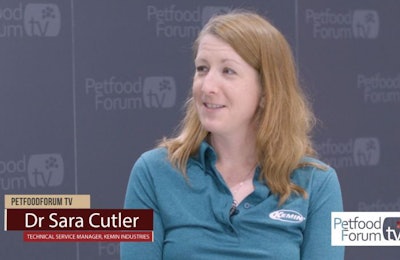
Consumer demands often shape pet food formulation, said Sara Cutler, PhD, technical service manager for Kemin Industries, in the video below from Petfood Forum 2017. Pet food trends, such as gluten-free, no corn, no wheat or no soy, force pet food manufacturers to substitute ingredients. Those substitutions can cause challenges.
“If you start substituting ingredients out then you can change the shelf life of the diet,” she said. “A lot of times those decisions are made based on making the package look good or making the diet appealing to the consumer, not necessarily making it shelf life stable.”
Importance of shelf-stable ingredients in pet food
The stability of fats are particularly important to pet food, she said. Since fats go on the outside of kibble, it's very important to prevent the formation of off odors.
Protein sources are another pet food ingredient that depend on shelf-life.
“The freshness of that material going in there really impacts how well the diet performs well as and how it tastes to the pet, and if they accept it or not,” Cutler said.
Petfood Forum 2018
Learn more about how consumer demands affect pet food formulation at Petfood Forum 2018. Petfood Forum provides an opportunity for pet food professionals from around the world to network, exchange ideas and do business with one another and with the industry's leading pet food manufacturers and suppliers. Petfood Forum 2018 will take place at the Kansas City Convention Center in Kansas City, Missouri, USA on April 23 -25, 2018.
















